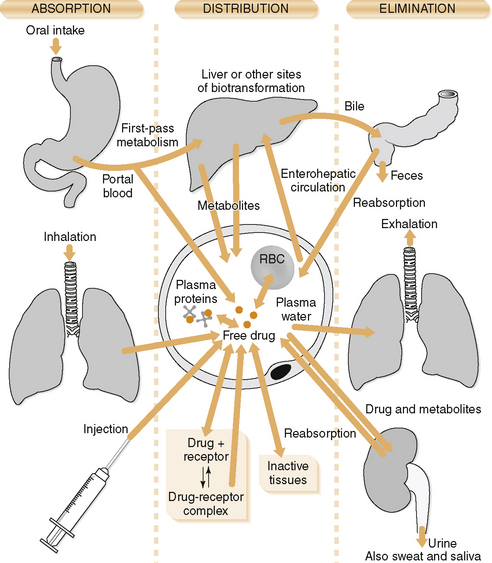What is the process by which a drug is transported by circulating body fluids to receptor sites?
Biotransformation
Distribution
Osmosis
Absorption
The Correct Answer is B
Choice A Reason:
Biotransformation, also known as drug metabolism, is the process by which the body chemically alters a drug. This typically occurs in the liver and results in the conversion of the drug into metabolites, which can be more easily excreted from the body. Biotransformation is crucial for drug elimination but is not the process by which a drug is transported to receptor sites.
Choice B Reason:
Distribution is the correct answer. This process involves the dispersion of a drug throughout the body via the bloodstream after it has been absorbed. The drug is transported to various tissues and organs, including the target receptor sites where it exerts its therapeutic effects. Distribution is influenced by factors such as blood flow, tissue permeability, and the binding of the drug to plasma proteins.
Choice C Reason:
Osmosis is the movement of water molecules across a semipermeable membrane from an area of lower solute concentration to an area of higher solute concentration. While osmosis is a fundamental biological process, it is not involved in the transport of drugs to receptor sites.
Choice D Reason:
Absorption is the process by which a drug enters the bloodstream from its site of administration. This can occur through various routes, such as oral, intravenous, or transdermal. Absorption is the initial step in drug delivery, but it is not the process by which the drug is transported to receptor sites.
Nursing Test Bank
Naxlex Comprehensive Predictor Exams
Related Questions
Correct Answer is D
Explanation
Choice A: Excretion
Excretion is the process by which drugs and their metabolites are eliminated from the body, primarily through the kidneys (urine), but also via bile, sweat, saliva, and other routes. While excretion is a crucial phase of pharmacokinetics, it is not directly impacted by the first pass effect. The first pass effect primarily involves the metabolism of a drug before it reaches systemic circulation, which occurs prior to the excretion phase.
Choice B: Metabolism
The first pass effect, also known as first-pass metabolism or presystemic metabolism, significantly impacts the metabolism phase of pharmacokinetics. This phenomenon occurs when a drug is metabolized at a specific location in the body, such as the liver or gut wall, before it reaches systemic circulation. As a result, the concentration of the active drug is reduced, affecting its bioavailability. The liver is the primary site for this metabolic process, where enzymes break down the drug, potentially leading to a significant reduction in its therapeutic effect.
Choice C: Distribution
Distribution refers to the process by which a drug is transported from the bloodstream to various tissues and organs in the body. This phase is influenced by factors such as blood flow, tissue permeability, and binding to plasma proteins. However, the first pass effect does not directly alter the distribution phase. Instead, it affects the amount of drug that enters systemic circulation, which in turn can influence the extent of distribution.
Choice D: Absorption
Absorption is the process by which a drug enters the bloodstream from its site of administration. This phase is crucial for determining the onset of a drug’s action. While the first pass effect occurs after absorption, it does not directly change the absorption phase itself. Instead, it affects the drug’s concentration after it has been absorbed and before it reaches systemic circulation.

Correct Answer is A
Explanation
Choice A Reason:
Respiratory alkalosis occurs when a person breathes rapidly (hyperventilates), causing a decrease in carbon dioxide (CO2) levels in the blood. This reduction in CO2 leads to an increase in blood pH, resulting in alkalosis. Hyperventilation can be triggered by anxiety, fever, or other conditions that increase respiratory rate.
Choice B Reason:
Metabolic alkalosis is caused by an increase in bicarbonate (HCO3-) or a loss of hydrogen ions (H+), often due to vomiting, diuretic use, or excessive bicarbonate intake. It is not directly related to hyperventilation, which primarily affects CO2 levels rather than bicarbonate levels.
Choice C Reason:
Metabolic acidosis occurs when there is an excess of acid in the body or a loss of bicarbonate, often due to conditions like diabetic ketoacidosis, renal failure, or severe diarrhea. Hyperventilation does not cause metabolic acidosis; instead, it can be a compensatory response to metabolic acidosis to help lower CO2 levels and increase pH.
Choice D Reason:
Respiratory acidosis is caused by hypoventilation, where there is inadequate removal of CO2 from the body, leading to an increase in CO2 levels and a decrease in blood pH. This condition is the opposite of what occurs during hyperventilation, making this choice incorrect.
Whether you are a student looking to ace your exams or a practicing nurse seeking to enhance your expertise , our nursing education contents will empower you with the confidence and competence to make a difference in the lives of patients and become a respected leader in the healthcare field.
Visit Naxlex, invest in your future and unlock endless possibilities with our unparalleled nursing education contents today
Report Wrong Answer on the Current Question
Do you disagree with the answer? If yes, what is your expected answer? Explain.
Kindly be descriptive with the issue you are facing.
